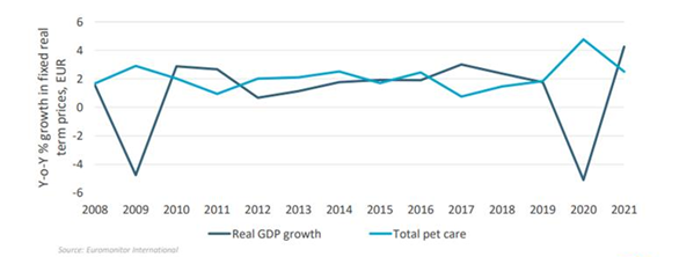At this year's Interzoo, the biggest trade fair for the pet industry worldwide, which took place in Nuremberg in May, there were, as always, many new and innovative products and ideas for the pet market to marvel at. Although there is an abundance of trends, there is one keyword that connects or explains, directly or indirectly, the majority of these trends: humanisation. This is not simply about giving a pet food or clothes that resemble human options, but about transferring the owner's values and needs to those of their pet.
In an attempt to anticipate the future trends of the pet industry, there is a need to identify which trends pet owners are following and which values are gaining strength. The starting point for the industry for the next few years is positive, because in most countries the number of pets has risen during the pandemic. However, manufacturers of pet food and accessories need to pay attention to changes in consumer behaviour, which can shift the direction of pet humanisation in the coming years.
From human to pet food: Meat alternatives, mood management and sustainable sourcing
The major trends in the market are being driven by pet owners. It is clear that pet food ingredients are following the same trends evident in the human food industry. Many manufacturers are trying to launch products with less or no meat in line with the strong trend towards sustainability. For example, there is vegetarian food for dogs, often criticised by veterinarians, and which is almost non-existent for cats. Other examples include using insects as a protein source, which might play a pioneering role as a first contact with the topic, before pet owners venture into foods based on insects for their own consumption.
In addition, many young start-ups have attempted to find distributors to sell their products enriched with hemp or CBD to pet owners that are aware of these trending ingredients in packaged food. These are often accompanied by claims that they are effective for pain relief or can reduce perceived stress, which owners are becoming increasingly aware of as they are also emerging as common issues for humans. They are thus more empathetic towards their pets. This is strongly influenced by the discussion about the legalisation of cannabis in several western countries such as Germany. Due to its relevance in the media and society lately, hemp (and CBD oil) is perceived as a kind of super food. However, the hype around this ingredient can quickly disappear as soon as social interest in cannabis wanes.
The search for these new ingredients often follows major trends, especially of a more sustainability-conscious diet for pet owners. Many are transferring their own values to their pets, especially to dogs and cats, and are also paying greater attention to the sustainable, organic production of pet food. Although it does not make a significant difference to the wellbeing of the pet, it is to be expected that new ingredients in pet food will continue to be based on the issue of a more conscious diet in the coming years.
From human to pet products: Pet fashion, dog drinks and gift packaging
From toothbrushes resembling human options to personalised pet clothing or dog beer, there appears to be room for almost any new idea in an industry which is, as data show, rather immune to financial crisis when consumers have less purchasing power; they still prefer to relinquish products or experiences for themselves than for their animal companions.
Real GDP growth compared to total pet care industry in % 2008-2021 (WE)

Pet care players are not only aware of the needs of owners when it comes to food. There is a trend which revolves around the design of the packaging, bringing it closer to any product for human consumption than ever before. This is particularly noticeable for new brands that need to catch consumers’ attention when they browse retailers’ shelves, as they attempt to penetrate the market. It is also an effective strategy for appealing to a younger audience that is more open to a fashionable and fresh design that expresses a brand´s personality and makes it easier to connect with. Indeed, offering gift packages is also gaining relevance as part of the way brands market certain products. This “giftability” adds value and can come in the form of a different packaging design that makes it look less ordinary or adds features for a certain functionality (such as a handle on a box) or article bundles that match as a set. This can be a solution to products that otherwise struggle to find a place in consumers’ regular baskets or more premium brands that are deemed too expensive but may still be perceived as a suitable gift.
In conclusion, the pet care industry is currently experiencing a period of major development, pushed mainly by the evolution of the relationship between pets and their human owners. As this connection focuses more on the needs of the pet, the values of the owner are likely to be transferred, drawing the aforementioned parallel between human and pet industries. Meat substitutes, alternative protein sources and a general increase of conscious and sustainable consumption will be key to both industries in the future, bringing new products and trends to the table that have not yet emerged.
For further insight, read our report, World Market for Pet Care.

